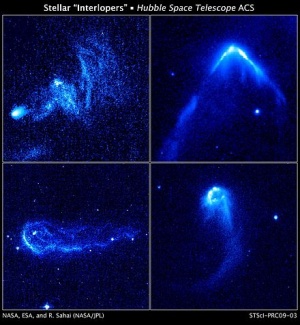Runaway Stars

A runaway star is one that is moving through space with an abnormally high velocity relative to the surrounding interstellar medium. The proper motion of a runaway star often points exactly away from a stellar association, of which the star was formerly a member, before it was hurled out.
Stellar kinematics is the study of the movement of stars without needing to understand how they acquired their motion. This differs from stellar dynamics, which takes into account gravitational effects. The motion of a star relative to the Sun can provide useful information about the origin and age of a star, as well as the structure and evolution of the surrounding part of the Milky Way.
In astronomy, it is widely accepted that most stars are born within molecular clouds known as stellar nurseries. The stars formed within such a cloud compose open clusters containing dozens to thousands of members. These clusters dissociate over time. Stars that separate themselves from the cluster's core are designated as members of the cluster's stellar association. If the remnant later drifts through the Milky Way as a coherent assemblage, then it is termed a moving group.
Two possible mechanisms may give rise to a runaway star:
In the first scenario, a close encounter between two binary systems may result in the disruption of both systems, with some of the stars being ejected at high velocities. In the second scenario, a supernova explosion in a multiple star system can result in the remaining components moving away at high speed.
Although both mechanisms are possible, astronomers generally favour the supernova mechanism as more common in practice.
One example of a related set of runaway stars is the case of AE Aurigae, 53 Arietis and Mu Columbae, all of which are moving away from each other at velocities of over 100 km/s (for comparison, the Sun moves through the Milky Way at about 20 km/s faster than the local average). Tracing their motions back, their paths intersect near to the Orion Nebula about 2 million years ago. Barnard's Loop is believed to be the remnant of the supernova that launched the other stars.
Another example is the X-ray object Vela X-1, where photodigital techniques reveal the presence of a typical supersonic bow shock hyperbola.[1]

